Bayes Rule vs The Millionaire Next Door
Tagged:CorporateLifeAndItsDiscontents
/
Investing
/
JournalClub
/
MathInTheNews
/
Retirement
/
R
/
SomebodyAskedMe
/
Statistics
Somebody asked me (back in 2012!) about the famous book, The Millionaire Next Door. It’s good as far as it goes; it just doesn’t go nearly as far as almost everybody thinks!
The Millionaire Next Door
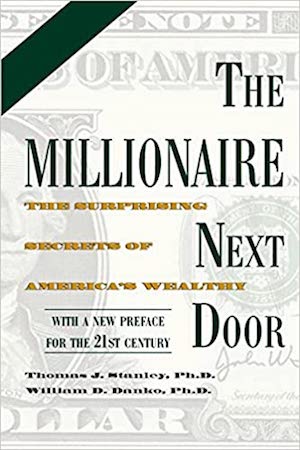 In 1996, Stanley & Danko published a now-famous book which amounted to an empirical
sociological survey of people in the US who were millionaires:
The Millionaire Next Door. [1]
To say the least, it struck a nerve. The empirical data did not confirm the stereotypes
of expensive clothes, cars, and jewelry. They did not live in large houses. They were
not lavish spenders.
In 1996, Stanley & Danko published a now-famous book which amounted to an empirical
sociological survey of people in the US who were millionaires:
The Millionaire Next Door. [1]
To say the least, it struck a nerve. The empirical data did not confirm the stereotypes
of expensive clothes, cars, and jewelry. They did not live in large houses. They were
not lavish spenders.
Stanley & Danko quoted the astonished words of a VP of a bank trust department [2]:
These people cannot be millionaires! They don’t look like millionaires, they don’t dress like millionaires, they don’t eat like millionaires, they don’t act like millionaires — they don’t even have millionaire names. Where are the millionaires who look like millionaires?
(Keep in mind this book was published 25 years ago. A million dollars in the US was significantly more money back then! According to the Bureau of Labor Statistics CPI inflation calculator, a million in 1996 is about $1.7 million in mid-2021.)
The main results of Stanley & Danko are:
- Millionaires don’t buy status junk. They tend to look pretty ordinary. They are not flashy at all. People who look flashy are cosplayers attempting to look rich. As an example, Stanley & Danko described their bank trust officer above as wearing a fancy suit, a $5000 watch, and driving a current-model luxury imported car. He was attempting to look rich, to win the trust of rich customers. He was not, himself, rich. (NB: billionaires, on the other hand, are a different sort of duck.)
- Millionaires spend less than they earn, and invest the difference. They don’t spend tomorrow’s money today, but have budgets.
- Millionaires take financial risk only when it’s worth it. They don’t buy lottery tickets, speculate in insanely risky investments like commodities/options/penny stocks, and they are adequately insured (health, life, disability, liability, etc.).
- Millionaires educate their kids in financial literacy, and get them into self-sustaining careers. Their kids are not continually needing parental support because they got good educations that led to useful, satisfying careers where they can support themselves (e.g., STEM degrees and professions). Or they started small businesses that had a shot at success.
They derived a jargony formula, for determining “average accumulators of wealth (AAW)” and “prodigious accumulators of wealth (PAW)”. Basically, for an AAW your age times your income, divided by 10, should be about your net worth excluding inheritances. A PAW should do about twice that. Here are some R functions to help you explore that:
mndAAW <- function(age, inc) { 0.1 * age * inc }
mndPAW <- function(age, inc) { 2 * mndAAW(age, inc) }
I once realized these could be worked backwards: given your age and net worth, what income would a PAW need to achieve that? If your income is lower, congratulations: you’re accumulating net worth even faster than a PAW. If your income is higher, figure out where you can spend more efficiently & save more.
pawInc <- function(age, nw) { 5 * nw / age }
What’s wrong with that?
So that’s… fine, I guess? It’s nice to know that the people in the upper middle class and the lower end of the upper class seem much more down to earth than the sociopathic billionaires. (I just made an interesting typo: “villionaires”, perhaps a portmanteau of “villain” and “billionaire”? Hmm.)
What got people’s engines revving, particularly those of the more feverishly conservative or libertarian sort, was that apparently 2/3 of the millionaires interviewed were owners of small businesses. “Aha! That’s for me,” they thought, “I’ll start a business and get rich!” They always think business owners are the saviors of society, and seized upon this as though it were empirical evidence.
That’s just… wrong.
First, the book is an empirical survey of people who are already millionaires. It is not a survey of the sorts of people who become millionaires and the ways they do that. It does not talk about all the people who resemble the interviewed millionaires but failed to become rich through bad luck, poor timing, isolated geography, or anything else.
Second, the misunderstanding betrays a fundamental ignorance of statistics. Stanley & Danko asked: if we sample millionaires, what sort of people are they? The fever dream people were doing the reverse: if we sample people of a certain sort, are they likely to be or become millionaires?
So there’s nothing at all wrong with Stanley & Danko’s book: it’s fine, as far as it goes. It just doesn’t go where most people think it goes!
Letting some air out of the balloon with Bayes Rule
We can show this, with some slight degree of melodrama, using Bayes’ Theorem.
Stanley & Danko’s research demonstrates that if you sample millionaires, you’re likely to find that about 2/3 of them own a business:
\[\Pr(\mathrm{business} | \mathrm{rich}) = 2/3\]But the question to which most readers wanted the answer was not about the characteristics of those already rich. Rather, they want to know what characteristics to adopt to become rich themselves. They want to know what’s the probability of achieving financial security, if they start a business:
\[\Pr(\mathrm{rich} | \mathrm{business}) = \mathrm{?}\]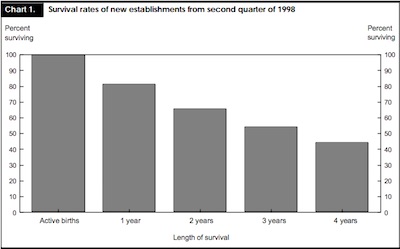 The truth is, most businesses flame out early: the US Bureau of Labor Statistics says
about 55% of businesses die within 4 years. [3] So there is
some danger here!
The truth is, most businesses flame out early: the US Bureau of Labor Statistics says
about 55% of businesses die within 4 years. [3] So there is
some danger here!
Can we estimate $\Pr(\mathrm{rich} | \mathrm{business})$ from $\Pr(\mathrm{business} | \mathrm{rich})$ and some ancillary data, to see what the actual chance of success at getting rich from a business is? Yes, that’s what Bayes’ Rule does for us:
\[\begin{align*} \Pr(\mathrm{rich} | \mathrm{business}) &= \frac{\Pr(\mathrm{business} | \mathrm{rich}) \times \Pr(\mathrm{rich})}{\Pr(\mathrm{business})} \\ &= \frac{\Pr(\mathrm{business} | \mathrm{rich}) \times \Pr(\mathrm{rich})}{\Pr(\mathrm{business} | \mathrm{rich}) \times \Pr(\mathrm{rich}) + \Pr(\mathrm{business} | \mathrm{nonrich}) \times \Pr(\mathrm{nonrich})} \end{align*}\]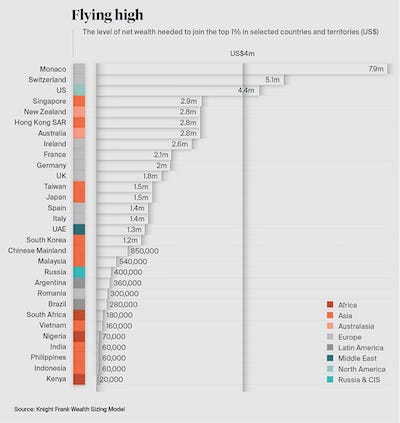
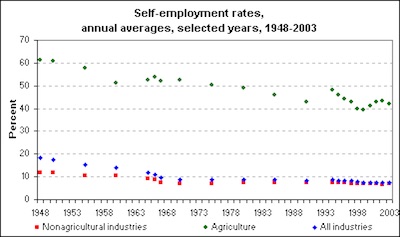 So we need to know $\Pr(\mathrm{rich})$ (the probability somebody is rich), and
$\Pr(\mathrm{business})$ (the probability they own a business):
So we need to know $\Pr(\mathrm{rich})$ (the probability somebody is rich), and
$\Pr(\mathrm{business})$ (the probability they own a business):
- For being “rich”, let’s target the top 1% of US wealth, which is about a net worth of $4.4 million. [4] Unsurprisingly, the probability of being in the top 1% is… 1%.
- A BLS statistic [5] tells us that about the self-employed component of the US has been declining over time, but is about 7.5% today. (Outside agriculture; agriculture is a whole different beast, but it is a terribly small part of the work force today.) We’ll use “self-employed” as a probable overestimate of the business-owners. We’ll also use this as a proxy for the “not rich” business owners, since we assume becoming rich is relatively rare.
So here’s what we know:
\[\begin{align*} \Pr(\mathrm{business} | \mathrm{rich}) &= 0.67 \\ \Pr(\mathrm{business} | \mathrm{nonrich}) &= 0.075 \\ \Pr(\mathrm{rich}) &= 0.01 \\ \Pr(\mathrm{nonrich}) &= 0.99 \end{align*}\]Plug that into Bayes’ Rule above:
\[\Pr(\mathrm{rich} | \mathrm{business}) = \frac{0.67 * 0.01}{0.67 * 0.01 + 0.075 * 0.99} = 8.3\%\]So basically, if you think owning a business is the road to riches, you’re thinking about a road with only an 8.3% chance of going where you want to end up! Ok, sure, that’s more than the 1% chance you’d have if you started at random, but 8.3% is by no means certain. All it says is that the business class is “enriched for richness”, not that starting a business will make you rich.
A modest counterpoint
Perhaps someone will point out, as someone always does, that the top 1% of the US is a bunch of evil super-villain billionaires. I mean, that’s factually false, since the data above says the entry threshold is $4.4 million, not a billion! (But see below: the 1%-ile threshold may be almost 3x higher, using different datasets.) But let’s indulge this theoretical critic, since critics are the most valuable friends an idea can have.
Instead, let’s just say the target for “rich” is being in the financial top 10% of the US. Surely that’s pretty comfortable? Wouldn’t we like to know if starting a business could at least raise the chance we could be comfortable?
Let’s see if that’s a possibility:
\[\Pr(\mathrm{rich} | \mathrm{business}) = \frac{0.67 * 0.10}{0.67 * 0.10 + 0.075 * 0.90} = 49.8\%\]Now there’s something to talk about: you get a 50% shot at being in the top decile of wealth. You’ve quintupled your chances.
Of course, there are other ways: get a good university degree perhaps in a STEM field, perhaps get an advanced degree, work in an industry that does some good in the world, live below your means and invest the difference. At retirement age, you’ll be comfortable.
The Weekend Conclusion
We’ve examined some popular sentiment about Stanley & Danko’s The Millionaire Next Door. As an exploratory study in the sociology of wealth in the US 25 years ago, there’s nothing at all wrong with it. Good work.
It does not, however, imply what many people think: owning a business is not a road to riches. The path to success there is only about 8.3%, after a Bayesian analysis. However, doing anything productive with your life, and then sustained over time, with reasonable spending budgets and intelligent investing… will likely have a good outcome.
There’s no magic here: you don’t have to be a business owner. You do have to be productive, patient, and reasonably able to budget.
Addendum 2021-Jun-02: What are the net worth deciles in the US, really?
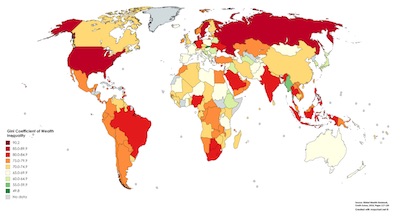 The claim that $4.4 million was the threshold for joining the 1% in the US just sticks in
my craw a little bit. We’re so desperately unequal, with a
Gini coefficient of 0.9, worse than in
the Gilded Age, that I find this hard to accept. Maybe it’s time to look at a second data
source.
The claim that $4.4 million was the threshold for joining the 1% in the US just sticks in
my craw a little bit. We’re so desperately unequal, with a
Gini coefficient of 0.9, worse than in
the Gilded Age, that I find this hard to accept. Maybe it’s time to look at a second data
source.
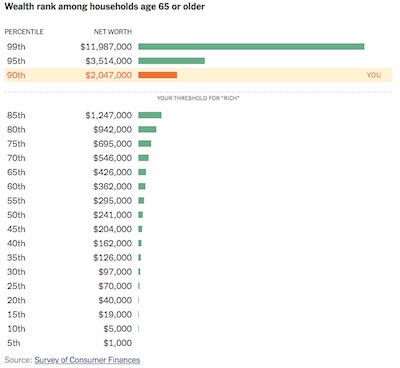 So I had a look at the net worth percentile calculator from the New York Times back in
2019, which is reasonably recent. [6] That does an
age-dependent net worth percentile calculation, so I assumed age 65+ to measure net worth
at the threshold of retirement. It’s based on the Federal Reserve’s Survey of Consumer
Finances for the years 2013 – 2016 (apparently Table 2, p 13).
[7]
So I had a look at the net worth percentile calculator from the New York Times back in
2019, which is reasonably recent. [6] That does an
age-dependent net worth percentile calculation, so I assumed age 65+ to measure net worth
at the threshold of retirement. It’s based on the Federal Reserve’s Survey of Consumer
Finances for the years 2013 – 2016 (apparently Table 2, p 13).
[7]
That confirmed a couple of things:
- The 99th percentile has a net worth above almost $12 million, substantially more than claimed in the Business Insider article, and more in line with my intuition.
- The 90th percentile, on the other hand was at a more negotiable threshold of $2 million or so. That’s more like something we can discuss as a goal for retiring “comfortably”, or a bit more than comfortably for most people.
So the calculation above for the 10%-ile is more relevant to Stanley & Danko’s work than the 1%-ile, who are über-wealthy. It doesn’t make sense that there’s any recipe for being in the 1%-ile, since they’re largely the result of inherited wealth or lightning-strike levels of good luck. But it does make some sense that sensible kinds of work (start a small business, or get a STEM degree and work in a productive industry) sustained patiently will reward one with entry to the top decile, or near there.
Notes & References
1: T Stanley & W Danko, The Millionaire Next Door, Pocket Books, 1996. ↩
2: T Stanley & W Danko, “The Millionaire Next Door: The Surprising Secrets of American’s Wealthy”, New York Times, 1996. ↩
3: A Knaup, “Survival and longevity in the Business Employment Dynamics data”, Monthly Labor Review, 2005-May. ↩
4: F Khaled, “This is how much you need to be worth to be in the richest 1% in the US — and other countries”, Business Insider, 2021-Feb-25. ↩
5: Bureau of Labor Statistics, “Self-employment rates, 1948-2003”, The Economics Daily at the US Dept of Labor, 2004-Aug-24 (retrieved 2021-May-28). ↩
6: NYT Interactive, “Are You Rich? Where Does Your Net Worth Rank in America?”, New York Times, 2019-Aug-12. ↩
7: J Bricker, et al., “Changes in U.S. Family Finances from 2013 to 2016: Evidence from the Survey of Consumer Finances”, Federal Reserve Bulletin 103:3, 2017-Sept.↩

Gestae Commentaria
Comments for this post are closed pending repair of the comment system, but the Email/Twitter/Mastodon icons at page-top always work.